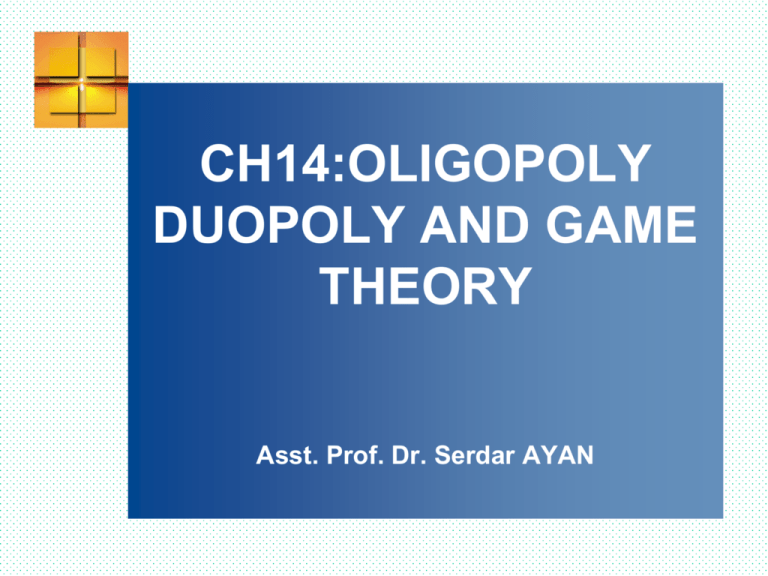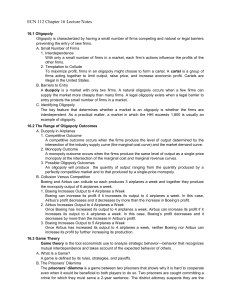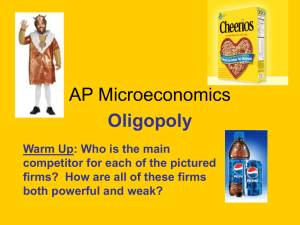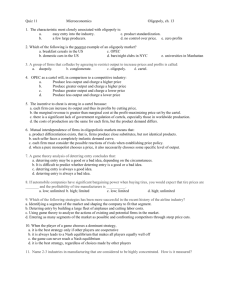game theory
advertisement

CH14:OLIGOPOLY DUOPOLY AND GAME THEORY Asst. Prof. Dr. Serdar AYAN WHAT IS OLIGOPOLY? Oligopoly is a market type in which: • A small number of firms compete. • Natural or legal barriers prevent the entry of new firms.. WHAT IS OLIGOPOLY? Small Number of Firms An oligopoly consists of a small number of firms. • Each firm has a large market share • The firms are interdependent • The firms are incentive to collude WHAT IS OLIGOPOLY? Interdependence When a small number of firms compete in a market, they are interdependent in the sense that the profit earned by each firm depends on the firms own actions and on the actions of the other firms. Before making a decision, each firm must consider how the other firms will react to its decision and influence its profit. WHAT IS OLIGOPOLY? Temptation to Collude When a small number of firms share a market, they can increase their profit by forming a cartel and acting like a monopoly. A cartel is a group of firms acting together to limit output, raise price, and increase economic profit. Cartels are illegal but they do operate in some markets. Despite the temptation to collude, cartels tend to collapse. WHAT IS OLIGOPOLY? Barriers to Entry Either natural or legal barriers to entry can create an oligopoly. Natural barriers arise from the combination of the demand for a product and economies of scale in producing it. If the demand for a product limits to a small number the firms that can earn an economic profit, there is a natural oligopoly. WHAT IS OLIGOPOLY? Figure (a) shows the case of a natural duopoly. A duopoly is a market with two firms. Here, where price equals minimum ATC, the lowest possible price, two firms can produce the quantity demanded in the market. RANGE OF OLIGOPOLY OUTCOMES Collusion Versus Competition By limiting production to the monopoly quantity, the firms can maximize joint profits. By increasing production, one firm might be able to make an even larger profit and force a smaller profit on to the other firm. RANGE OF OLIGOPOLY OUTCOMES Joint profits can be $72 million if the firms produce the monopoly output. RANGE OF OLIGOPOLY OUTCOMES Boeing Increases Output to 4 Airplanes a Week Boeing can increase its economic profit by $4 million and cause the economic profit of Airbus to fall by $6 million. RANGE OF OLIGOPOLY OUTCOMES Airbus Increases Output to 4 Airplanes a Week For Airbus this outcome is an improvement on the previous one by $2 million a week. For Boeing, the outcome is worse than the previous one by $8 million a week. RANGE OF OLIGOPOLY OUTCOMES Boeing Increases Output to 5 Airplanes a Week If Boeing Increases output to 5 Airplanes a week, its economic profit falls. Similarly, if Airbus Increases output to 5 Airplanes a week, its economic profit falls. RANGE OF OLIGOPOLY OUTCOMES A dilemma: • If both firms stick to the monopoly output, they both produce 3 airplanes and make $36 million. • If they both increase production to 4 airplanes a week, they both make $32 million. • If only one increases production to 4 airplanes a week, that firm makes $40 million. • What do they do? • Game theory provides an answer. GAME THEORY Game theory The tool used to analyze strategic behavior— behavior that recognizes mutual interdependence and takes account of the expected behavior of others. GAME THEORY What Is a Game? All games involve three features: • Rules • Strategies • Payoffs Prisoners’ dilemma A game between two prisoners that shows why it is hard to cooperate, even when it would be beneficial to both players to do so. GAME THEORY The Prisoners’ Dilemma Art and Bob been caught stealing a car: sentence is 2 years in jail. DA wants to convict them of a big bank robbery: sentence is 10 years in jail. DA has no evidence and to get the conviction, he makes the prisoners play a game. GAME THEORY Rules Players cannot communicate with one another. • If both confess to the larger crime, each will receive a sentence of 3 years for both crimes. • If one confesses and the accomplice does not, the one who confesses will receive a sentence of 1 year, while the accomplice receives a 10-year sentence. • If neither confesses, both receive a 2-year sentence. GAME THEORY Strategies The strategies of a game are all the possible outcomes of each player. The strategies in the prisoners’ dilemma are: • Confess to the bank robbery • Deny the bank robbery GAME THEORY Payoffs Four outcomes: • Both confess. • Both deny. • Art confesses and Bob denies. • Bob confesses and Art denies. A payoff matrix is a table that shows the payoffs for every possible action by each player given every possible action by the other player. GAME THEORY This table shows the prisoners’ dilemma payoff matrix for Art and Bob. GAME THEORY Equilibrium Occurs when each player takes the best possible action given the action of the other player. Nash equilibrium An equilibrium in which each player takes the best possible action given the action of the other player. GAME THEORY The Nash equilibrium for Art and Bob is to confess. Not the Best Outcome The equilibrium of the prisoners’ dilemma is not the best outcome. GAME THEORY The Duopolists’ Dilemma Each firm has two strategies. It can produce airplanes at the rate of: • 3 a week • 4 a week GAME THEORY Because each firm has two strategies, there are four possible combinations of actions: • Both firms produce 3 a week (monopoly outcome). • Both firms produce 4 a week. • Airbus produces 3 a week and Boeing produces 4 a week. • Boeing produces 3 a week and Airbus produces 4 a week. GAME THEORY The Payoff Matrix This table shows the payoff matrix as the economic profits for each firm in each possible outcome. GAME THEORY Equilibrium of the Duopolists’ Dilemma Both firms produce 4 a week. Like the prisoners, the duopolists fail to cooperate and get a worse outcome than the one that cooperation would deliver. GAME THEORY Collusion is Profitable but Difficult to Achieve The duopolists’ dilemma explains why it is difficult for firms to collude and achieve the maximum monopoly profit. Even if collusion were legal, it would be individually rational for each firm to cheat on a collusive agreement and increase output. In an international oil cartel, OPEC, countries frequently break the cartel agreement and overproduce.









